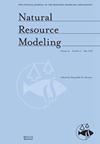埃塞俄比亚Omo - Gibe盆地Ajora - Woybo流域土地利用和土地覆盖的历史和未来动态及其驱动因素
IF 2.1
4区 环境科学与生态学
Q3 ENVIRONMENTAL SCIENCES
引用次数: 6
摘要
土地利用和土地覆被动态一直被认为是自然资源变化的重要驱动因素。因此,了解流域LULC的时空变化对有效的自然资源管理和长期发展至关重要。本研究试图分析1990 - 2020年Ajora - Woybo流域的动态和变化驱动因素,并预测2035年和2050年的情况。利用ArcGIS 10.3和ERDAS 2015对Landsat影像的定量数据进行分析。对于监督图像分类,使用最大似然分类算法。为了确定驱动变量,进行了焦点小组和关键举报人访谈。利用TerrSet 18.31软件,利用多层感知器神经网络和元胞自动机-马尔可夫链模型对土地变化模型进行预测。研究发现了耕地、人工地、灌丛地、林地、裸地和水体等6种土地类型。在过去的三十年里,耕地、建筑面积和裸地的增加是以牺牲灌木地和林地为代价的。水体变化趋势既有减少趋势,也有增加趋势。根据预测结果,耕地、人工地和裸地增加,灌丛地和林地减少。最后,农业扩张、人口增长、木材开采、移民安置、城市化和缺乏环境考虑被确定为LULC变化的主要驱动因素。研究表明,流域LULC发生了显著变化。因此,扭转预测条件对于确保流域的长期生存能力至关重要。本文章由计算机程序翻译,如有差异,请以英文原文为准。
Historical and future dynamics of land use land cover and its drivers in Ajora‐Woybo watershed, Omo‐Gibe basin, Ethiopia
Land use land cover (LULC) dynamics have long been recognized as a significant driver of natural resource change. As a result, understanding the spatial and temporal variation of LULC in the watershed is essential for effective natural resource management and long‐term development. This study attempts to analyze the dynamics and change drivers from 1990 to 2020 and predict the situation for 2035 and 2050 in the Ajora‐Woybo watershed. ArcGIS 10.3 and ERDAS 2015 were used to analyze quantitative data from Landsat imagery. For supervised image classification, a Maximum‐Likelihood classification algorithm was used. To identify driver variables, focus groups and key informants' interviews were done. TerrSet 18.31 software was used to predict LULC utilizing the Multi‐Layer Perceptron Neural Network and Cellular Automata‐Markov Chain models incorporated in Land Change Modeler. Six LULC classes were discovered: cultivated land, built‐up, shrub land, forest land, bare land, and water body. Cultivated land, built‐up area, and bare land have increased at the expense of shrub land and forest land over the last three decades. Trends in water bodies show both decreasing and increasing trends. According to the predicted outcomes, cultivated land, built‐up and bare land has increased, while shrub land and forest land have declined. Finally, agricultural expansion, population growth, wood extraction, resettlement, urbanization, and lack of environmental consideration were identified as the major drivers of LULC change. The study demonstrated that there have been significant changes in the watershed LULC. As a result, reversing the predicted conditions is critical to ensuring the watershed long‐term viability.
求助全文
通过发布文献求助,成功后即可免费获取论文全文。
去求助
来源期刊

Natural Resource Modeling
环境科学-环境科学
CiteScore
3.50
自引率
6.20%
发文量
28
审稿时长
>36 weeks
期刊介绍:
Natural Resource Modeling is an international journal devoted to mathematical modeling of natural resource systems. It reflects the conceptual and methodological core that is common to model building throughout disciplines including such fields as forestry, fisheries, economics and ecology. This core draws upon the analytical and methodological apparatus of mathematics, statistics, and scientific computing.
 求助内容:
求助内容: 应助结果提醒方式:
应助结果提醒方式:


